The study site used for lobster tracking studies
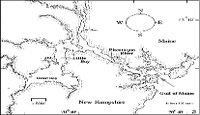 Figure 1 |
|
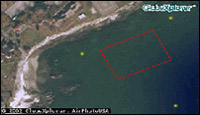 Figure 2 |
|
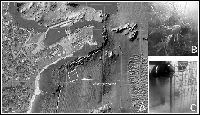 Figure 3 |
|
 Figure 4 |
|
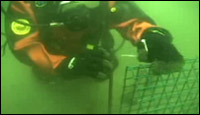 Video 1 (Click to play) |
|
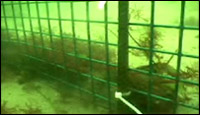 Video 2 (Click to play) |
The mesocosm used for this study is located in a cove adjacent to the UNH Coastal Marine Laboratory in Newcastle, N.H. The mesocosm consists of a 50 meter X 50 meter portion of the bottom surrounded by a 1 meter high fence. The depth in the area of the mesocosm is ~ 7-10 meters and the temperature ranges from 10-18 C during the time frame of our studies (see temperature profile below). Below are several images of the area, as well as some underwater views. Click on images to enlarge.
An aerial photograph of the study site is shown in Figure 2, with the location of the mesocosm (red) and the VEMCO sonabuoys (yellow) is shown above.
This area of the N.H. seacoast has been mapped using sweepscan sonar technology by the UNH Center for Coastal and Ocean Mapping (CCOM). A composite satellite image and sweep-scan image of the area around our study site is shown in Figure 3 (A). The study site is outlined in white (compass directions shown as well; the r stands for the reference pinger). Shallow areas that were not mapped are in gray. Panel B is a picture of a lobster in the eelgrass bed that dominates the northwest corner of the mesocosm. The fence surrounding the mesocosm can be seen in the right hand corner of the picture. Panel C shows a diver constructing the fence that surrounds the mesocosm.
Figure 4 is a view of the study site, taken from the southeast, with the coast guard station and lighthouse in the background. The UNH CML is located in one of the coastguard buildings on the west side of the point. Data from the study site is transmitted to a base station located in the NMFS offices in the tall white building to the left of the lighthouse.
The purpose of the wall surrounding the mesocosm is to prevent lobsters inside the study area from escaping. In previous lobster tracking studies lobsters equipped with transmitters would typically move out of the range of the tracking system. The wall of the mesocosm, with its inward facing lip, prevents this problem and allows us to track lobsters in the 2500 square meter mesocosm for as long as we want. Furthermore, after a typical 5-10 day trial, we are able to retrieve the lobsters, remove the transmitter, let them free and use the expensive transmitter on another lobster.
Video 1 shows some of the construction of the fence surrounding the mesocosm. Ten foot sections of fence are secured to the bottom using rebar and cable-ties.
